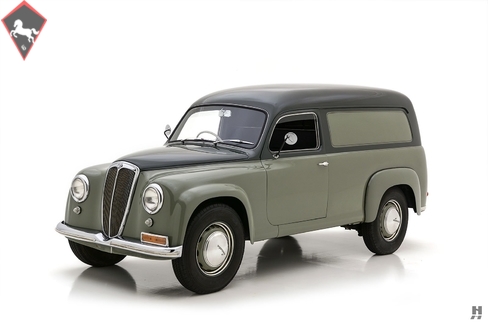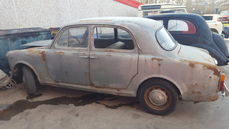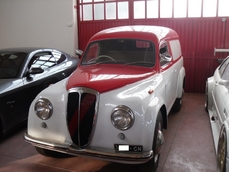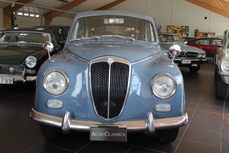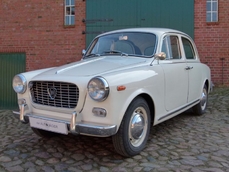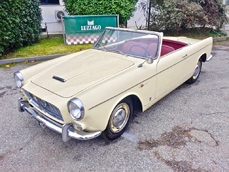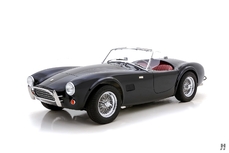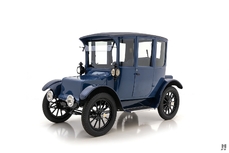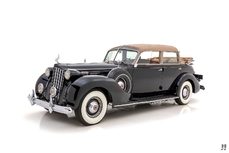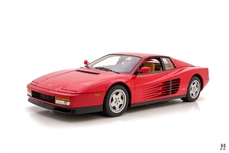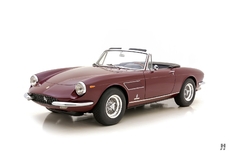Lancia Appia Van 1956
General description :
Lancia introduced the all-new Appia at the 1953 Turin Salon. The long-awaited replacement for the outgoing Ardea, the Appia served as Lancia’s entry-level model below the fabulous Aurelia. The entirely-new Appia shared only the old Ardea’s layout of a front-mounted V4 driving the rear wheels via a live axle, but the engine, gearbox, and platform were designed from the ground up. It was a busy time for Lancia, with the factory also working on a replacement for the Aprilia, and revamping the racing cars. The legendary engineer Vittorio Jano seemed to be burning the candle at both ends, developing new race engines while still finding time to dedicate to production cars. For the Appia, he created a brilliant new narrow-angle V4 engine. The new V4 shared little with the outgoing overhead cam unit, reverting to pushrod valve actuation, with twin camshafts mounted low in the cylinder block, topped with a single aluminum cylinder head. The narrow 14-degree V-angle kept the engine extremely compact, although it was somewhat tall. At 1,090 cc, it was the same dimensions as a contemporary Fiat 1100 and made a modest 38 horsepower at 4400 rpm in standard form, giving the lightweight Appia platform lively performance. Power went to the rear wheels via a 4-speed manual gearbox with synchro on the top three forward gears, shifted via a column-mounted lever as was de rigueur for Lancia in the 1950s.
Similar to its larger siblings, the Appia chassis featured patented sliding pillar front suspension, live axle on leaf springs, and an incredibly sturdy monocoque platform. The robust structure not only gave the Appia unrivaled rigidity and quality, but it allowed for a wide variety of body styles to be easily adapted, and the factory offered the option of a bare chassis for coachbuilders. The Appia proved to be wildly successful, with saloon sales topping 100,000 cars over ten years.
In addition to the standard four-door saloon, and coachbuilt models, buyers could select a light commercial version of the Appia designated the C80, C83 or C86. These models featured a slightly detuned version of the 1,090 cc V4 (for durability), larger 16-inch wheels and tires to carry a higher payload, and could be specified as a pickup (Camioncino), small delivery van (Furgoncino), or ambulance (Autolettiga). A short rear axle ratio and 5-speed gearbox compensated for the detuned engine and made the Appia surprisingly capable even when carrying a load. The commercial Appia is considerably rarer than its saloon counterpart, with production touching just 8,000 units between 1954 and 1959.
Featured here is a lovely example of Lancia’s endearing Appia Furgoncino. Hailing from 1956, this is a Series II C 80 model and is believed to be one of approximately 2,900 of its kind produced. It is in home market specification with right-hand drive, as Italy was one of the last holdouts of left-hand traffic on mainland Europe after the war. While the commercial Appia was relatively popular in its day, as with any commercial vehicle, attrition rates are high as these little trucks were subjected to daily abuse. Thankfully, this wonderful Furgoncino (literally, “small van”) lived a gentle enough life to earn a well-deserved restoration back to original specs. According to a previous owner, the ground-up restoration was done in Switzerland and has seen only light use since. The paintwork presents in good condition, showing a few minor imperfections in the finish but otherwise well-detailed. Typical for Lancias of the era, the body is beautifully crafted with doors that open and shut with Mercedes-like solidity, and a sensation of quality that belies its purpose as an economical delivery car. Chrome adornments are minimal but present in good condition overall. Some polish marks are evident in the bumper, while the Carello headlight rims and proud Lancia radiator grille are excellent. Polished aluminum hubcaps adorn the correct 16-inch wheels with period-correct Michelin X radials (Lancia was an early adopter and champion of the radial tire). At the back, twin barn-doors open up to a generous cargo area with a spare wheel neatly slotted below the load floor.
The driver’s compartment is neat, tidy and suitably minimalist, with hard-wearing vinyl upholstery on the bench seat and door panels, and durable rubber floor mats. Switches, controls, and the instrument cluster appear to be in superb original condition. The original ivory steering wheel has a few cracks, yet it conforms nicely to the charming and honest presentation of the cabin.
Lancia’s brilliant, energetic little V4 engine sits beneath the bonnet, fed by a single Weber carburetor on a side-mounted manifold. This example retains the original, commercial-spec 5-speed manual gearbox, and it sounds absolutely marvelous on the go. The presentation is tidy and authentic, with a mix of lightly restored and original components and fittings. Even for their utility vehicles, Lancia did not cut out the lovely details, evident by touches like the Lancia logo cast into the exhaust manifold and the lubrication chart printed on the underside of the bonnet.
This rare and delightful Appia Furgonchino is a wonderful example of Lancia’s ingenuity, unmistakable style, and exquisite craftsmanship. It would make an eye-catching promotional piece for a business, or a fabulous and unique pit car for vintage racing and period revival meetings like Goodwood. However the next caretaker chooses to enjoy it, this Appia will be a worthy addition to any collection of Lancia automobiles.
Offers welcome and trades considered
https://hymanltd.com/vehicles/6528
1956 Lancia Appia Van is listed sold on ClassicDigest in St. Louis by Mark Hyman for $63500.
Car Facts
Car type : Car Make : Lancia Model : Appia Model Version : Van Engine size : 0.0 Model Year : 1956 Sub type : Van Location : Missouri
Sold
Seller Information
Sold
People who viewed this Lancia Appia also viewed similar Lancia listed at ClassicDigest
Other cars listed for sale by this dealer
About Lancia
Ah, Lancia, the Italian marque that danced on the edge of automotive brilliance! Let me take you on a journey through the captivating story of Lancia, a brand that embodies passion, innovation, and rallying prowess.Act 1: The Early Years (1906-1920s)
Lancia was founded in 1906 by Vincenzo Lancia, an engineering wizard with a flair for the extraordinary. The brand quickly gained a reputation for its precision engineering and innovative approach. The Lancia Alpha, introduced in 1907, was the first car to feature a narrow-angle V4 engine, setting the tone for Lancia's commitment to technical excellence.
Act 2: Innovation at its Core (1930s-1950s)
The 1930s saw Lancia pushing the boundaries of innovation with models like the Lambda, the first car to feature a load-bearing monocoque chassis. The Aprilia, introduced in the 1930s, showcased cutting-edge aerodynamics and a V4 engine, solidifying Lancia's reputation as a pioneer.
Act 3: Post-War Elegance (1950s-1960s)
After World War II, Lancia continued to dazzle with models like the Aurelia, the first production car to feature a V6 engine. It blended performance with comfort and elegance. The Flaminia followed, embodying luxury and advanced engineering.
Act 4: Rally Domination (1970s-1980s)
Lancia etched its name in motorsport history with an unparalleled rally legacy. The Lancia Stratos, a wedge-shaped wonder, dominated the rally scene in the 1970s, clinching three consecutive World Rally Championships from 1974 to 1976. The Delta Integrale, introduced in the 1980s, continued this rally reign with multiple championships.
Act 5: Struggles and Resilience (1990s-2000s)
The latter part of the 20th century brought financial challenges for Lancia, leading to collaborations with other automakers. Despite the difficulties, Lancia introduced models like the Thesis and the Ypsilon, showcasing its commitment to style and substance.
Act 6: 21st Century Reinvention (2010s-Present)
In the 2010s, Lancia faced a shift in strategy, focusing on the Ypsilon as its primary model. While production numbers dwindled, the brand maintained its reputation for distinctive design and comfort.
Epilogue: A Legacy of Passion and Innovation
Lancia's story is one of passion, innovation, and motorsport glory. The brand, with its groundbreaking designs, technological advancements, and rallying triumphs, has left an indelible mark on the automotive world. Lancia may have faced challenges in recent years, but its legacy lives on, celebrated by enthusiasts who recognize the magic woven into each Lancia creation. Finally, Here are some of the most important Lancia models that have left an enduring mark:
1. Lancia Lambda (1922-1931):
The Lancia Lambda is often considered a pioneering model, being the first car to feature a load-bearing monocoque chassis. This innovation set the stage for modern automotive design. The Lambda was available in various body styles and showcased Lancia's commitment to engineering excellence.
2. Lancia Aurelia (1950-1958):
The Aurelia, introduced in the early 1950s, was a groundbreaking model for Lancia. It was the first production car to feature a V6 engine, and it incorporated advanced engineering, including a rear transaxle and inboard rear brakes. The Aurelia set new standards for performance and comfort.
3. Lancia Flaminia (1957-1970):
Continuing Lancia's tradition of combining style with innovation, the Flaminia was introduced as a luxury sedan. It featured a V6 engine, a de Dion rear suspension, and avant-garde styling. The Flaminia further solidified Lancia's reputation for producing high-end, technically advanced vehicles.
4. Lancia Stratos (1973-1978):
The Lancia Stratos is an icon in the world of rallying. Born out of Lancia's rallying ambitions, the Stratos was purpose-built for competition. With its distinctive wedge-shaped design and a mid-mounted V6 engine, it became the first car to win the World Rally Championship three times consecutively from 1974 to 1976.
5. Lancia Delta (1979-1994):
The Lancia Delta is synonymous with rally success. It dominated the rally scene in the late '80s and early '90s, winning six consecutive manufacturers' titles in the World Rally Championship. The Delta's combination of performance, agility, and versatility made it an icon both on and off the rally stages.
6. Lancia Thema 8.32 (1986-1994):
The Lancia Thema 8.32 was a performance-oriented version of the Thema sedan, and it stood out for its collaboration with Ferrari. It featured a 3.0-liter V8 engine sourced from Ferrari, making it one of the few sedans with a Ferrari powerplant. This model showcased Lancia's ability to blend luxury and performance.
